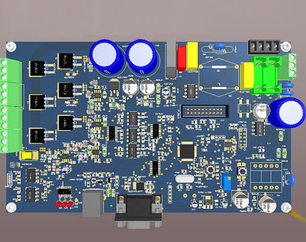1. CAF and Dendrites of the finished board
Once the finished PCB board absorbs water, or uses water-soluble flux for lead-free soldering, the risk of bad "anode fiberglass yarn leakage" will greatly increase. The best way for F R-4 to avoid CA F is to change the original Dicy hardener with high polarity and high hygroscopicity to PN hardener with low moisture absorption. The latter is about 10% more expensive in terms of cost, and when the amount of addition increases, it also causes problems such as embrittlement of the sheet and poor process coordination. In order to let the readers have a holistic view of C AF, the characteristics of the two epoxy resin hardeners are sorted out as follows for reference;
Secondly, the empty board before the green paint construction must be thoroughly cleaned, and Fina 1 C 1 e an ing must be completed and must pass the cleanliness test to avoid "copper branch leakage between the dense wires under the green paint after lead-free soldering. "(Dendrite)'s troubles. Generally, the Fina1 C1eaning and cleanliness inspection is performed after the green paint before shipment, but it is not correct, and it should be changed before the green paint.

Comparison of characteristics of F R-4 epoxy resin polymerization hardener
Second, component parts MSL
Various components (Devices) and parts (Parts) mounted on the surface of the PCB circuit board, due to their different packaging methods, have different moisture absorption effects in the environment. This kind of incomplete sealing and other components, the sensitivity to moisture (MSL) and future troubles, also become worse in the lead-free manufacturing process. In other words, the components and parts absorb moisture to a certain extent. Originally, they were safe when soldering with lead, but when they were lead-free, they became more stressed, and the problem of frequent bursting and damage was repeated.
In order to avoid lead-free high heat damage and parts as early as possible, the latest revision of MSL specification PC/JEDEC J-STD-020C clearly lists 8 types of "Moisture Sensitivity Levels" (MSL) in the table and the table as a reminder Assemblers adopt different countermeasures for different parts during lead-free soldering. For example, the most sensitive Level 6, which should be welded within the time allowed by the label, should almost be completed after being folded; and for Level 3, the welding must be completed within 1 week. Otherwise, once the parts are damaged after soldering, it is a pseudoword for ignorant users to come back and blame the solder or the inappropriateness of the Profile or PCB. PCB and component manufacturers must know this to avoid indifferent claims.
In order to further standardize lead-free SAC soldering, J-STD-020C compares the lead-free and lead-free operating profiles carefully, and sets some practical parameters for easy reference by the industry.
3. Conclusion
The pace of full lead-free is getting closer, and some of the various hardships that have been suffered by the early-start PCB industry are seldom willing to discuss openly for the sake of business competition and face issues. The author can only sort out some context for reference based on the latest published papers and my own practical experience. I hope that some disasters can be reduced in advance, and that is enough.